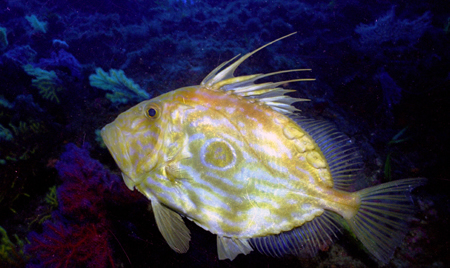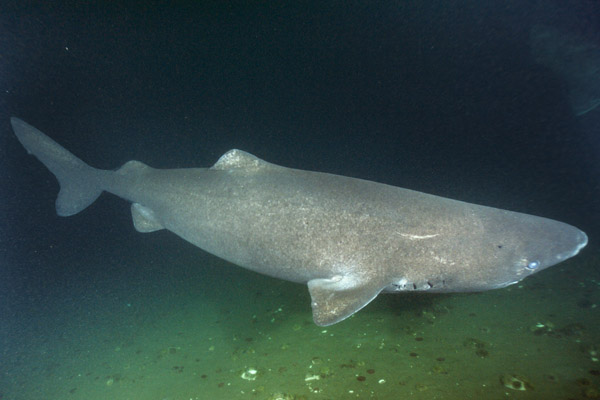|
DEMERSAL FISH
Demersal fish live and feed on or near the bottom of seas or lakes (the demersal zone). They occupy the sea floors and lake beds, which usually consist of mud, sand, gravel or rocks. In coastal waters they are found on or near the continental shelf, and in deep waters they are found on or near the continental slope or along the continental rise. They are not generally found in the deepest waters, such as abyssal depths or on the abyssal plain, but they can be found around seamounts and islands. The word demersal comes from the Latin demergere, which means to sink.
Demersal fish are bottom feeders. They can be contrasted with pelagic fish which live and feed away from the bottom in the open water column. Demersal fish fillets contain little fish oil (one to four percent), whereas pelagic fish can contain up to 30 percent.
Types
Demersal fish can be divided into two main types: strictly benthic fish which can rest on the sea floor, and benthopelagic fish which can float in the water column just above the sea floor.
Benthopelagic fish have neutral buoyancy, so they can float at depth without much effort, while strictly benthic fish are more dense, with negative buoyancy so they can lie on the bottom without any effort. Most demersal fish are benthopelagic.
As with other bottom feeders, a mechanism to deal with substrate is often necessary. With demersal fish the sand is usually pumped out of the mouth through the gill slit. Most demersal fish exhibit a flat ventral region so as to more easily rest their body on the substrate.
The exception may be the flatfish, which are laterally depressed but lie on their sides. Also, many exhibit what is termed an "inferior" mouth, which means that the mouth is pointed downwards; this is beneficial as their food is often going to be below them in the substrate. Those bottom feeders with upward-pointing mouths, such as stargazers, tend to seize swimming prey.
Coastal demersal fish are found on or near the seabed of coastal waters between the shoreline and the edge of the continental shelf, where the shelf drops into the deep ocean. Since the continental shelf is generally less than 200 metres deep, this means that coastal waters are generally epipelagic. The term includes demersal reef fish and demersal fish that inhabit estuaries, inlets and bays.

|
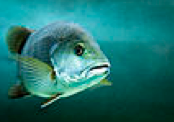
|
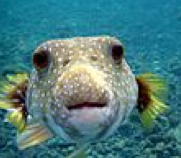
|
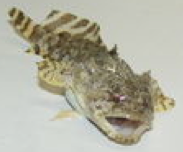
|
Triggerfish use a jet of water to
uncover
sand dollars buried in sand |
The mangrove jack eatscrustaceans |
Many puffer fish species crush
the shells of molluscs |
The venomous toadfish, a benthic
ambush predator, blends into
sandy or muddy bottoms |
Deep water demersal fish occupy the benthic regions beyond the continental margins.
On the continental slope, demersal fishes are common. They are more diverse than coastal demersal fish, since there is more habitat diversity. Further out are the abyssal plains. These flat, featureless regions occupy about 40 percent of the ocean floor. They are covered with sediment but largely devoid of benthic life (benthos). Deep sea benthic fishes are more likely to associate with canyons or rock outcroppings among the plains, where invertebrate communities are established. Undersea mountains (seamounts) can intercept deep sea currents, and cause productive upwellings which support benthic fish. Undersea mountain ranges can separate underwater regions into different ecosystems.
Rattails and brotulas are common, and other well-established families are eels, eelpouts, hagfishes,greeneyes, batfishes and lumpfishes.
The bodies of deep water demersal fishes are muscular with well developed organs. In this way they are closer to mesopelagic fishes thanbathypelagic fishes. In other ways, they are more variable. Photophores are usually absent, eyes and swimbladders range from absent to well developed. They vary in size, and larger species, greater than one metre, are not uncommon. |
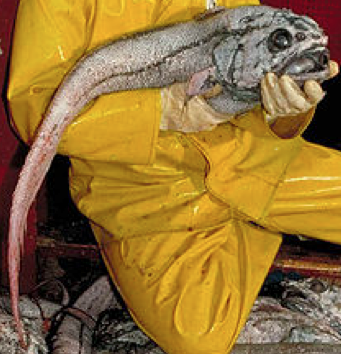 |
Deep sea demersal fish are usually long and narrow. Many are eels or shaped like eels. This may be because long bodies have long lateral lines. Lateral lines detect low-frequency sounds, and some demersal fishes have muscles that drum such sounds to attract mates. Smell is also important, as indicated by the rapidity with which demersal fish find traps baited with bait fish.
The main diet of deep sea demersal fish is invertebrates of the deep sea benthos and carrion. Smell, touch and lateral line sensitivities seem to be the main sensory devices for locating these.
Like coastal demersal fish, deep sea demersal fish can be divided into benthic fish and benthopelagic fish, where the benthic fish are negatively buoyant and benthopelagic fish are neutrally buoyant.
The availability of plankton for food diminishes rapidly with depth. At 1000 metres, the biomass of plankton is typically about 1 percent of that at the surface, and at 5000 metres about 0.01 percent. Given there is no sunlight, energy enters deep water zones as organic matter. There are three main ways this happens. Firstly, organic matter can move into the zone from the continental landmass, for example, through currents that carry the matter down rivers, then plume along the continental shelf and finally spill down the continental slope. Other matter enters as particulate matter raining down from the overhead water column in the form of marine snow, or as sinking overhead plant material such as eelgrass, or as "large particles" such as dead fish and whales sinking to the bottom. A third way energy can arrive is through fish, such as vertically migrating mesopelagic fishes that can enter into the demersal zone as they ascend or descend. The demersal fish and invertebrates consume organic matter that does arrive, break it down and recycle it. A consequence of these energy delivery mechanisms is that the abundance of demersal fish and invertebrates gradually decrease as the distance from continental shorelines increases.
Although deep water demersal fish species are not generally picky about what they eat, there is still some degree of specialisation. For example, different fish have different mouth sizes, which determines the size of the prey they can handle. Some feed mostly on benthopelagic organisms. Others fed mostly on epifauna (invertebrates on top of the seafloor surface, also called epibenthos), or alternatively on infauna (invertebrates that burrow into the seafloor substrate). Infauna feeders can have considerable sediment in their stomachs. Scavengers, such as eels and hagfish, also eat infauna as a secondary food source. |
Source:
http://en.wikipedia.org/wiki/Demersal_fish |

